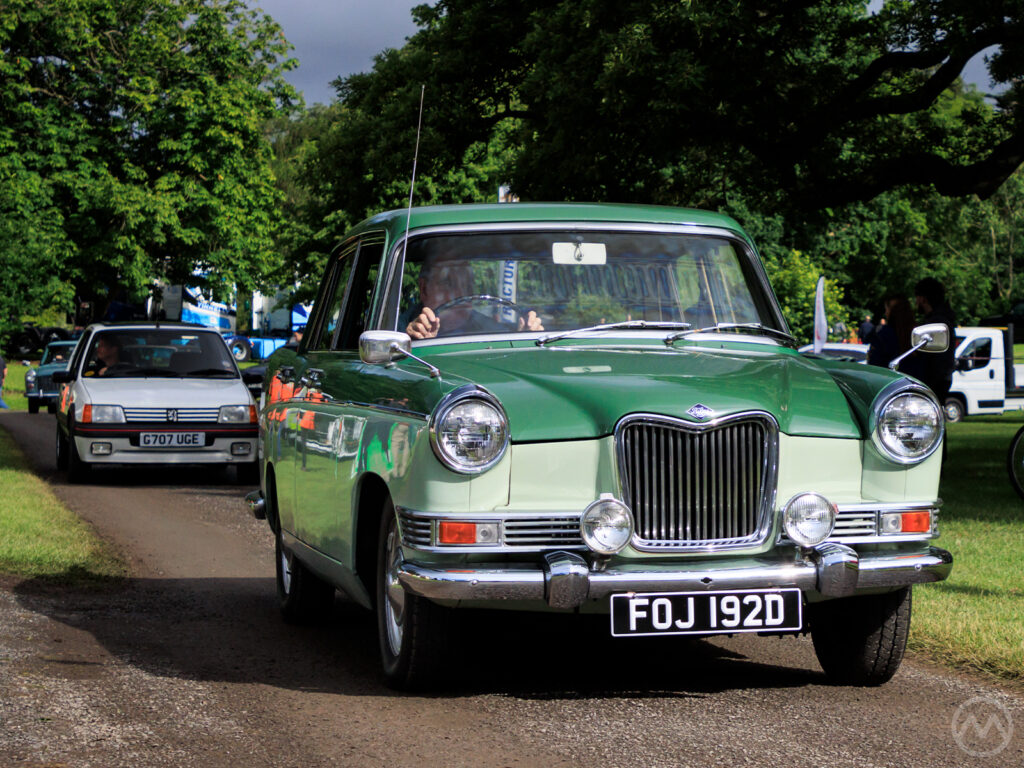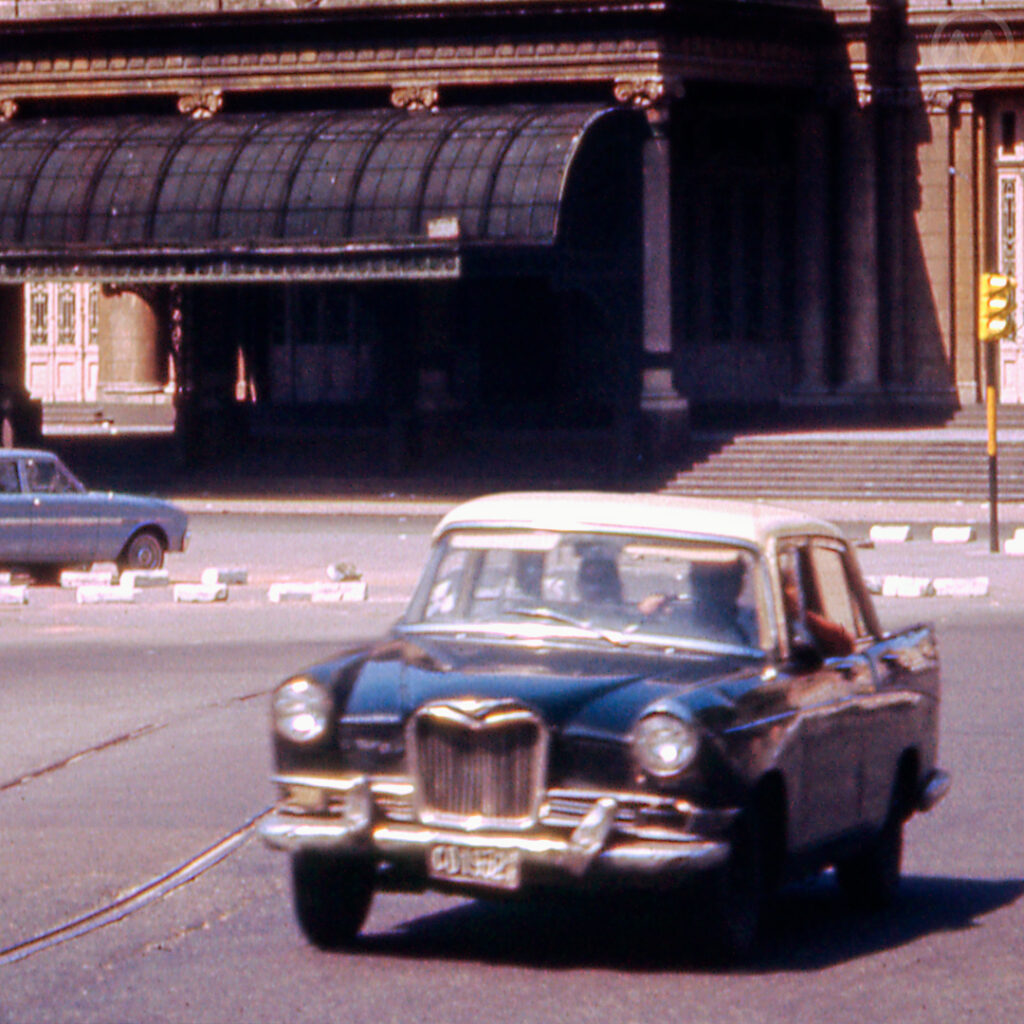Another distant trip today through the OldMotors archives, this time to Buenos Aires, Argentina, in the 1960s. That’s el Teatro Colón in the background, Argentina’s most famous opera house and no doubt the primary subject of this photo. The taxi that’s about to rattle past the camera is our focus, however. At first glance, it looks like a Riley 4/72, an obscure car to U.S. readers but well known in the U.K. It isn’t, in fact, a Riley; though it is a close relative.
It’s a Siam di Tella 1500. A what?
First, there’s no connection to Thailand here. Despite the name, the Siam is a native Argentine. The name began as an acronym for Sección Industrial Amasadoras Mecánicas (SIAM, the original name roughly translated to “mechanical mixer industrial concern”). Later, it was also recorded as Sociedad Industrial Americana de Maquinarias.
As a part of Argentina’s Law of Foreign Investment reforms during the 1958-62 Presidency of Arturo Frondizi, the company inked a deal with British Motor Corporation (BMC) to build locally-assembled versions of the “Big Farina” sedan, one version of which was the Riley 4/72. That’s what became the Siam di Tella 1500, which is a badge-engineered but also license-built car. Not long after, they also started building a version of the old Austin A55 pickup, eventually leading to a Farina-based pickup/ute, the Siam di Tella Argenta.

Argentina’s Rocky Road to Car Production
Founded by Italian immigrant Torcuato di Tella in 1911 (three years after Teatro Colón opened), the company made industrial bread mixers but later got big by building oil pipeline components. The 1930 coup, however, meant turning to household goods. Political instability is never good for industry. There were some parallels to other automotive tales in di Tella’s story.
Di Tella’s real fortune came from refrigerators, rather like Renzo Rivolta at Iso. Only much later did it branch into cars, just like Wolseley, which had its origins in Herbert Austin’s work for the original Wolseley sheep-shearing machine manufacturer.
Torcuato di Tella created his empire from nothing, but he took a personal interest in the management of his factories and openly courted organized labor, himself drafting several workplace safety laws, with his goal being to improve standards of living in Argentina. Because industrial development and politics were closely linked in Argentina, he had the connections to help. In return, his company became Argentina’s largest industrial powerhouse in the pre-ww2 era.
The original patriarch died in 1948, and his sons Guido and Turcuato Jr. took over the company during the Juan Perón era. Turcuato Sr., who despised demagogues, was emphatically *not* a fan. In expanding their industrial efforts, the sons arranged to produce their first motor vehicle: the Siambretta. As the name implies, this was a licensed version of the Lambretta scooter. With that experience, the firm was primed to make a car, but that only happened after the revolution that deposed Perón.

In his place came Frondizi, the first elected post-Perón President and a technocrat who had industrial development foremost in his mind. He was accompanied by Rogelio Frigerio, a Perónist who served as Secretary of Socio-Economic Affairs but who was really Argentina’s de facto minister of industry. The industrial reforms they had in mind made the BMC deal happen.
Argentina was dependent on expensive car imports at the time, and growing a domestic industry was of the utmost importance in boosting wages and providing home-grown vehicles. Indeed, an earlier plan during the Perón era had produced a national car, the Justicalista, a pet project of Perón’s that was hampered by his insistence on building a sports car. The project went nowhere.
After 1955, more serious efforts at building a national industry began, with the interim government inking a deal with Kaiser to produce Kaiser sedans, Willys Aeros and Jeeps locally. In 1958, almost 80% of the cars built in Argentina (less than 30,000 total) were Kaiser relatives built by the new company, Industrias Kaiser Argentina (IKA). In 1959, Renault took a big stake in IKA.
SIAM was an even better bet, given that it had such lengthy industrial experience and was entirely a home-grown company. In late 1958 Siam arranged to build the di Tella 1500 powered by a low-compression BMC B-series four, with various modifications at the SIAM factory on the outskirts of Buenos Aires.

Siam di Tella 1500
The Siam di Tella 1500 used the Riley’s front clip but other elements from the Austin A60, and while twin carbs were an option, they were rarely seen.
The “Big Farina” was a much more fuel-efficient car than most American imports or locally-built American cars, but without too much space sacrifice. It was dead reliable too. That made it a very popular car with Buenos Aires cabbies, and a big percentage of Siam di Tella 1500 production ended up ferrying passengers around Argentine cities. Twin carbs weren’t needed, or really desired, for such a role.
A “Traveller” wagon followed the regular 1500, and eventually the ute version as well, replacing the old A55-based pickup. Some later versions incorporated more of the MG Magnette version of the Farina into their styling.
In the meantime, Frondizi’s plan to liberalize ownership rules and encourage joint ventures worked, and by 1966, Argentina was dominated by locally assembled foreign cars. He himself had been deposed by then, when right-wing elements in the Argentine military objected to his allowing former Perónists to run in free and fair elections (he was repeatedly accused of being a Marxist, despite his expansion of the industrial state) — one of many turbulent political moments and democratic setbacks in Argentina and a taste of worse things to come in the 1970s.
The success of foreign partners hurt SIAM, as it couldn’t match the economies of scale of big foreign investors like Ford and Renault (whose products you can see in the background). After about 61,000 cars had been built, IKA took over SIAM’s car division in 1966. It continued to build the cars, but now marketed the main car as the Magnette and eventually all the models under Morris and MG labels.
But that didn’t last long. In 1967, Renault took over IKA and shuttered the line for good. The Siam di Tella is almost unknown outside of Argentina, and photos of them in service are pretty rare. It’s blurry, but you won’t see it in too many other places!

